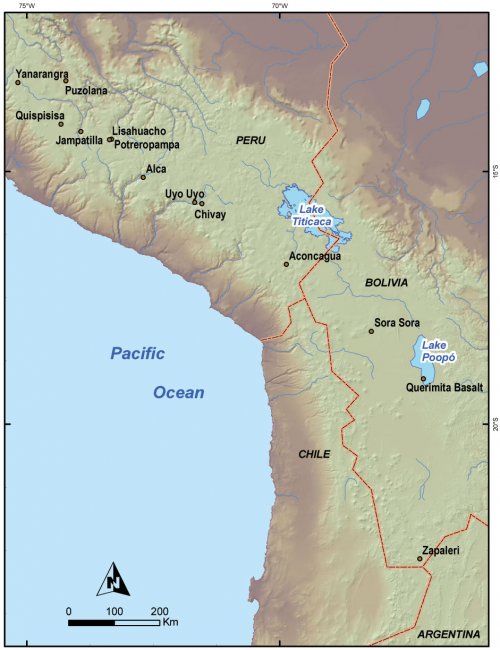4.2. Tectonic geology
The Colca Valley lies on the western margins of the broadest region of the Andean cordillera at 15° south. The Andes consist of several parallel mountain chains and in this region that includes areas of southern Peru, western Bolivia, and northern Chile the parallel chains separate and landforms between these mountain chains comprise the broad, high-altitude valleys and plateaus known collectively as the altiplano. The altiplano is a treeless region at an average altitude of 3700 masl extending from the Lake Titicaca Basin to Bolivia's Lake Poopó thatis second only to the Tibetan Plateau as the largest plateau in the world (Clapperton 1993: 45-47;Pearson 1951). The Quechua term punafor "elevated area" applies to the ecological band of the altiplano, but punacan also refer to a broader regions and life zones. The steep Andean cordillera includes volcanism over some of the thickest crusts in the world (Aramaki, et al. 1984: 217), and has resulted in the steep mountains and compressed ecological zonation that strongly influences human organization and subsistence strategies in the region (Troll 1968;Winterhalder and Thomas 1978).
Figure 4-12. Select raw material sources in the central Andes.
|
Name |
Latitude |
Longitude |
Other names |
Reference |
|
Chivay |
-15.6421 |
-71.5356 |
Titicaca Basin, Cotallalli |
Burger, et al. 1998, Brooks, et al. 1997 |
|
Aconcagua |
-16.8422 |
-69.8632 |
Aconcahua |
Frye, Aldenderfer, Glascock 1998 |
|
Quispisisa |
-14.0663 |
-74.3188 |
Burger et al., 2000, 2001, 2002. |
|
|
Zapaleri |
-22.6711 |
-67.2280 |
Yacobaccio et al, 2004 |
|
|
Sora Sora |
-18.1661 |
-68.1831 |
Giesso, 2002, pers. comm. |
|
|
Jampatilla |
-14.2125 |
-73.9279 |
Pampas |
Burger,et al. 1998. |
|
Puzolana |
-13.2090 |
-74.2225 |
Ayacucho |
Burger, et al. 2005 |
|
Alca |
-15.1202 |
-72.6928 |
Umasca, Cusco Source |
Burger 1998, Jennings, et al. 2002 |
|
Querimita Basalt |
-19.1079 |
-67.1553 |
Giesso 2000, 2003 |
|
|
Uyo Uyo |
-15.6155 |
-71.6760 |
Brooks 1998, Wernke 2003 |
|
|
Yanarangra |
-13.2432 |
-75.1721 |
Mistaken for Quispisisa |
Glascock, et. al., in press. |
|
Potreropampa |
-14.3632 |
-73.3220 |
Andahuaylas A |
Glascock, et. al., in press. |
|
Lisahuacho |
-14.3732 |
-73.3620 |
Andahuaylas B |
Glascock, et. al., in press. |
Table 4-3. Coordinates and names of select raw material sources in the central Andes. Coordinates in WGS1984 datum.
It is volcanic processes at a continental scale that have resulted in the discrete pattern of obsidian sources in the central Andes in an arching line between 3000 and 5000 meters above sea level. As discussed by Clapperton (1993)and Thorpe et al. (1982;1981), the volcanic origins of these features involves a consideration of plate tectonics in western South America. Off of the coast of Peru the oceanic Nazca plate is subducting beneath the South American plate, resulting in the magmatism, seismicity, and tectonism characteristic of the central Andes. Geologists date the initial uplift and deformation of the Andean geosyncline to the Laramine Orogeny during the middle Cretaceous period, a period of worldwide mountain building. The Andean batholith, a massive igneous intrusion that underlies the western range of the central Andes (Cordillera Occidental), formed during this orogenic period. The eastern range of the central Andes (Cordillera Oriental) arose from laterally compressed geosynclinal rocks that emerged as folded stratigraphy. The trench between the western batholith and the folded eastern stratigraphy, known as the Titicaca trough, continued to accumulate sediments through the Miocene. A quiescent period followed when the central Andean region matured through erosive processes into a relatively level surface of the altiplano, moderating the terrain that lay above the volcanic, sedimentary, and metamorphic layers that make up the structure of the Andes. This surface undergoing erosion could not properly be called the altiplanoduring the Late Miocene because, interestingly, the surface was still under 1800 masl by 10 Ma (Gregory-Wodzicki 2000). Estimates of uplift rates on the order of 0.2 - 0.3 mm/yr have created the raised plateau known as the Altiplano from the Miocene to the present. Recent estimates by Thouret et al. based on incision dates in major canyons of Ocona below the Cotahuasi valley suggest that "downcutting may have taken place before 9 Ma but most likely before 3.8 Ma and again before 2.7 Ma, based on dated valley infillings" (Thouret, et al. 2005). They suggest that accelerated valley incision was due to increased runoff that resulted from glaciation of the high Andean peaks, and by implication the Chivay obsidian source was at already at high altitude, probably covered by glaciers, by some time in the Late Miocene and Pliocene. Given the
